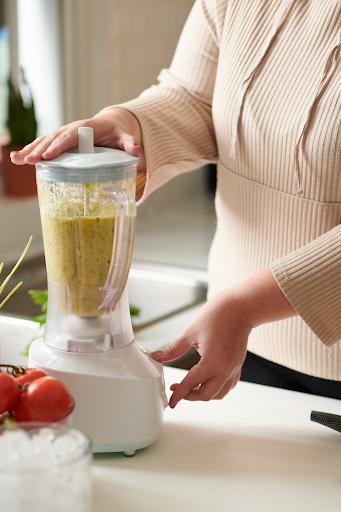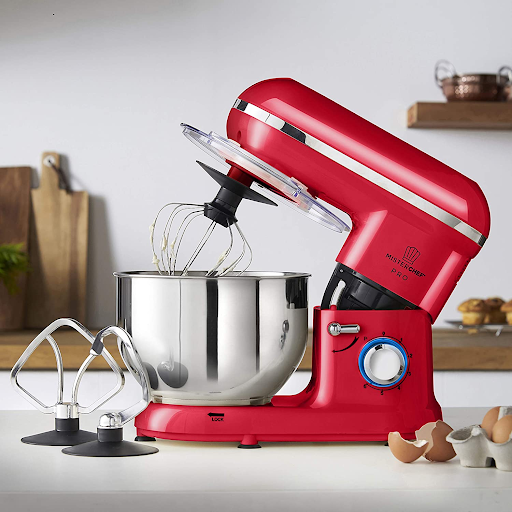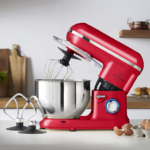Food Processor vs Stand Mixer: Which One Should You Pick?
Food processors and stand mixers are both electronic appliances designed to simplify kitchen tasks. But both of these tools are designed for different purposes. If you’re looking to buy but unsure which to choose, or if you’re considering getting both, here’s a detailed guide to help you out.
What Are Food Processors?

A food processor is a kitchen appliance designed to make food preparation tasks quicker and easier. It includes a base that houses the motor, a bowl with a lid, and a feed tube for adding ingredients. It also comes with various attachments such as an S-shaped blade (also known as a sabatier blade) for chopping and pureeing, and disks for shredding and slicing. Some models also include attachments that knead pizza, bread, and fresh pasta dough, grind nuts and spices, crush ice, chop vegetables, and mix dressings and sauces.
Pros of Using Food Processors
- Food processors can do multiple kitchen tasks with one device, from chopping vegetables and making bread crumbs to kneading pasta, bread, and pizza dough.
- They significantly cut down on how long it takes to prepare ingredients.
- They provide uniform results, whether you’re slicing, dicing, or pureeing.
- Food processors have a large bowl capacity, which is great for preparing meals for families or batch cooking.
Cons of Using Food Processors
- Food processors can be a bit tedious to clean since they come with multiple attachments and blades.
- They can be loud when in operation.
- They might be large and require a large amount of storage or counter space.
- It may take some time to learn how to use all the attachments and get the best results.
Factors to Consider When Buying a Food Processor
Deciding to buy a food processor is the first step. The next is choosing the right one for your kitchen. Here are some key points to keep in mind when buying a food processor:
1) Size and Capacity
The size and capacity of a food processor will determine how much food you can process in a single serving. The mini food processors generally have a 3-cup capacity which is great for single servings and for simple tasks such as grinding spices and chopping herbs. If you want something bigger, you can go for the larger size which generally has a 14-cup capacity. It’s ideal for family meals, if you cook frequently and for harder tasks.
2) Power of Motor
The next important factor to consider is the motor’s power. Look for food processors with at least 600 watts of power, especially if you’ll be working with hard foods like nuts or dough. A more powerful motor means the processor can handle tougher tasks without straining.
3) Attachments and Accessories
The attachments and accessories of your food processor will determine what you can use it for. Basic models include minimal attachments for tasks like slicing, grating, and chopping. More advanced models come with extras like dough blades, whisks, and citrus presses. Think about what attachments you’ll actually use to avoid paying extra for unnecessary ones.
4) Ease of Cleaning and Safety
Since food processors have multiple parts and attachments, they can be a bit of a hassle to clean. Look for models that are dishwasher-safe or easy to clean by hand to save time and effort. Also, to ensure safety, pick food processors with features such as non-slip feet and a locking lid.
What Are Stand Mixers?

Stand mixers are powerful kitchen appliances designed for mixing, kneading, and whipping ingredients. They consist of a stationary base that holds a mixing bowl and an arm with a mixer attachment that rotates. They have various attachments, such as a paddle, whisk, and dough hook. They are especially used to whip cream, mix cakes, and knead bread dough.
Pros of Using Stand Mixers
- Stand mixers are great for mixing tasks and can handle thick doughs and batters that might be challenging to mix by hand or with a hand mixer.
- Once you start the mixer, it does all the work for you. This frees up your time to do other tasks.
- With a range of attachments available, stand mixers like the MisterChef Professional Stand Mixer can be used for more than just mixing. They can also knead dough, whip cream, beat eggs, and even grind meat or pasta with the right accessories.
- The bowls of stand mixers are typically larger than those of food processors, making them ideal for making big batches of dough, batter, or frosting.
Cons of Using Stand Mixers
- Stand mixers can be a bit more expensive when compared to food processors.
- They can take up considerable space and are heavy, which might be an issue if you have a smaller kitchen.
- While many parts are dishwasher-safe, cleaning a stand mixer and its attachments can sometimes be difficult, especially if bread or cookie dough gets stuck in the attachments.
- Stand mixers may not work as well for very small quantities since the attachments might not reach all the ingredients in the bowl.
Factors to Consider When Buying a Stand Mixer
Choosing the right stand mixer is about finding the balance between your baking needs and your kitchen space. Here are important factors to guide you:
1) Power and Speed
When picking the most reliable stand mixer, a general guideline is to go for the most powerful one, usually over 300 watts. More powerful mixers can handle larger volumes and thicker doughs without straining. Also, consider the number of speed settings available, as different tasks require different speeds.
2) Size and Capacity
Similar to food processors, stand mixers usually come with bowls of different sizes, usually measured in quarts. If you’re cooking for two and have limited kitchen space, choose the standard size, which is typically around 4.5 to 5.5 quarts. If you have a larger family and more kitchen space, opt for the larger models, which are around 6 to 8 quarts.
3) Attachments and Accessories
Next, consider the attachments and accessories you need. Basic stand mixers come with a whisk, dough hook, and beater. Some models offer additional attachments like vegetable spiralizers, meat grinders, or pasta rollers. Consider what you’re going to use your stand mixer for.
4) Decide on the Type
Stand mixers can be of two types: tilt-head and bowl type. The tilt-head design makes it convenient to add ingredients or remove the bowl without having to move the entire appliance. It’s ideal for smaller quantities and easier mixing tasks. On the other hand, a bowl-lift stand mixer has a stationary head and a lever that raises and lowers the bowl. It’s ideal for heavy-duty mixing tasks and larger quantities.
Which One Should You Choose?
If you find yourself baking often, kneading dough for bread, or whipping up batches of cookies, a stand mixer might be the best choice for you. On the other hand, if you’re more into preparing meals that require chopping, slicing, shredding, or pureeing, a food processor might be better. If you love both baking and cooking and have enough money and space, think about getting both appliances.
Summary
Both the food processor and the stand mixer have their place in the kitchen. Your choice should depend on your cooking style, preferences, and the types of recipes you most often prepare.
Ready to take your baking to the next level? Check out MisterChef’s Professional Stand Mixer. With its powerful motor and multiple attachments, it’s designed to handle all your baking needs effortlessly. From airy meringues to perfect doughs, our stand mixer can do it all. Shop with us today.






